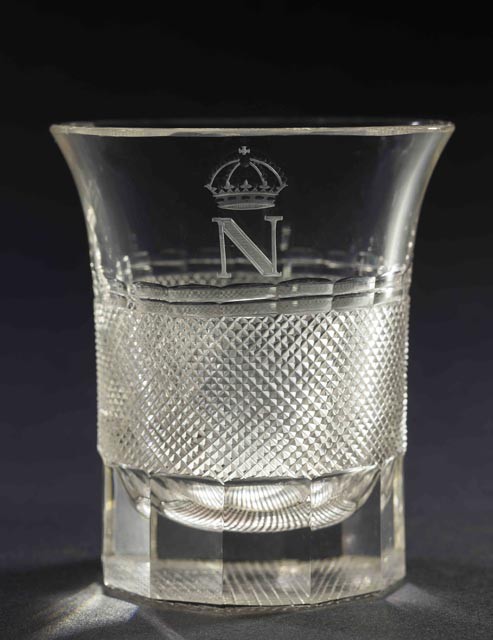The majority of glassware for the Maison de l’Empereur or Imperial Household came from the Montcenis crystal manufacturer. The Montcenis firm, established in 1787, had been the official crystal manufacturers to the monarch during the Ancien Régime, and they would play a significant role in the development of the French glass- and crystalware industry. So much so, indeed, that at the beginning of the nineteenth century these luxury products would rival English crystal. At the 1806 Exposition des produits de l’industrie trade fair established by Napoleon, Montcenis crystal won a gold medal for the perfection of its products. With Ladoueppe du Fougerais (1766-1821) as its director, the Montcenis crystalworks received the coveted status “by imperial appointment” with the title Manufacture de Leurs Majestés impériales et royales. They became known for their innovative designs, ever going so far as to create a different style of glass to be used for sparkling wines from the Champagne region, namely the champagne flute. The Montcenis crystal manufactory also produced gobelets, in other words, a sort of tumbler, like that shown here donated to the Fondation Napoléon.
This so-called Dutch cylindrical form splayed at the rim is notable for its diamond point pattern in its lower section. The base has a twelve-sided form, whilst the body of the gobelet itself is rounded. The reason for the sumptuous workmanship (if reason need be) is no doubt to be found in the identity of the customer, namely, the Maison de l’Empereur, as shown by the engraved “N” topped with an imperial crown on the upper, splayed section of the glass. This gobelet, an exquisitely carved tumbler, twelve-sided on the outside and with a rounded wineglass shape on the inside, lived in a case when accompanying the Emperor on his travels.
Even on campaign, Napoleon continued to use objects befitting his rank. At every stop, he demanded the same campaign furniture. The Maison d’Empereur was therefore obliged to ensure the maintenance of Napoleon’s typical routines and, in general, to follow Imperial Palace etiquette scrupulously. Since these objects were of such remarkable workmanship and value, they were generally protected from any accidents that might occur while travelling by carrying cases, themselves finely crafted. Examples of such cases include those for the china “Headquarter’s service” (see Fondation Napoléon, inv. 792-14) and those protecting gold items, including the cutlery bearing the Emperor’s coat of arms (inv. 967). The same applies for the glassworks – this gobelet, given to the Fondation Napoléon by Mr Jean-Claude Lachnitt, has a cylindrical carrying case. Its interior is lined with green silk, and the exterior is made of brown morocco goat leather decorated in gold with the imperial symbol of the bee, and at the rim, the letter “N” under the imperial crown. This gobelet would have been an everyday object in the Emperor’s bivouac and was probably used during Napoleon’s last campaigns in 1814 and 1815.
There are few comparable models of this gobelet – only four are known. One belongs to a private collection, the other is at the Napoleon Museum at Thurgau, located in the Schloss and park of Arenenberg, and the last two belong to the Fondation Napoléon. Of all comparable models, that donated by Mr Jean-Claude Lachnitt is undoubtedly the most remarkable. Thanks to the ideal conditions in which the gobelet has been stored, the leather’s texture is still soft and its colour has not faded. Furthermore, there are no chips on the surface of the crystal.
By virtue of its quality, this object has attracted the attention of many exhibition curators. In 2015, it was exhibited at the Wellington Museum in Waterloo as part of the exhibition “Napoléon – Wellington: Destins Croisés” (in French). On 18 September 2015, it was loaned to the Mobilier National for an exhibition in the “Galerie des Gobelins” entitled “Le Bivouac de Napoléon, luxe et ingéniosité en campagne”. Thus, this campaign gobelet finds itself again amongst the other objects that formed part of Napoleon’s life in the bivouac.
Elodie Lefort November 2015, (trans. Tiara Ataii)


